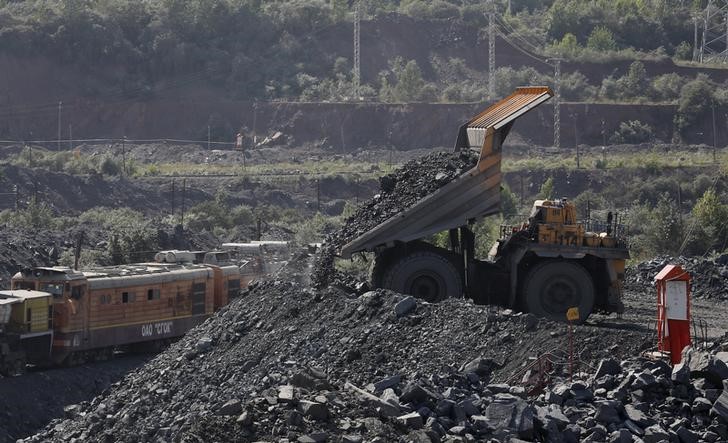(Repeats with no changes to text)
By Clyde Russell
LAUNCESTON, Australia, Jan 27 (Reuters) - - Iron ore heavyweights Australia and Brazil are gaining market share in top buyer China, but aren't quite destroying their smaller rivals as quickly as they need to.
Australia shipped 607.4 million tonnes of iron ore to China in 2015, a gain of 10.8 percent on the prior year, according to Chinese customs data published on Tuesday. exports totalled 191.6 million tonnes, up 12.1 percent over 2014, the data showed.
In terms of market share, Australia's jumped from 58.8 percent of China's imports in 2014 to 63.7 percent last year, while Brazil's went from 18.3 percent to 20.1 percent.
So far so good for the big producers, Brazil's Vale VALE5.SA , the Anglo-Australian majors Rio Tinto (L:RIO) RIO.AX and BHP Billiton (L:BLT) BHP.AX , and No.4 Fortescue Metals Group FMG.AX .
There are two pillars that the iron ore majors have used to justify their massive expansion projects over the past five years.
The first is that they can become the lowest cost producers and use that advantage to drive smaller competitors from the seaborne iron ore market.
The second is that China's industrialisation still has many years left to run, and steel demand will rise to around an annual 1 billion tonnes in the coming years.
The big miners have largely delivered on the first part of their strategy, driving costs down to levels where a tonne of iron ore can be delivered to its export port for a few dollars below the $20 a tonne mark.
This means they can still make money even with the Asian spot price .IO62-CNI=SI at $40.80 a tonne, which is 43 percent down from the start of last year and barely a fifth of the all-time high from early 2011.
The Chinese data also show that while Australia and Brazil have increased their share of China's imports, so too have the next two biggest suppliers, South Africa and Ukraine.
South Africa supplied 45.4 million tonnes to China in 2015, up around 4 percent on the prior year. Its market share increased from 4.6 percent to 4.8 percent.
Imports from Ukraine were 20.2 million tonnes, up about 9 percent year-on-year, giving the troubled East European country a 2.1 percent share of China's market, up from 2 percent in 2014.
COMPETITORS STILL SHIPPING
While it's true that South Africa and Ukraine are minnows in the overall China iron ore story, it's instructive that the four big miners have been unable to knock them out of the game.
For Vale, Rio Tinto, BHP and Fortescue to get even close to justifying the billions of dollars spent building their capacity, they really have to utterly dominate the seaborne trade.
In 2015, there were 153.9 million tonnes of Chinese iron ore imports that weren't supplied from Australia and Brazil.
It's these tonnes that the big four miners have to snaffle in order to control supply to the point where there may even be a chance of a sustained rally in iron ore prices.
But experience has shown that miners can cling on for longer than expected, through a combination of cost-cutting, high-grading and running down previously built-up cash reserves.
It may be harder to get rid of South Africa's iron ore exports, given its currency ZAR= has fallen almost 42 percent against the U.S. dollar since the start of 2015, while Australia's AUD= has dropped only 14 percent over the same period.
While Australia and Brazil may be able to take some more market share in 2016, it seems unlikely that they will be able to grab the majority of the 153.9 million tonnes they didn't supply in 2015.
There is also the real possibility that China's iron ore imports may decline this year, after posting a modest gain of 2.16 percent last year.
China's steel output dropped 2.3 percent to 803.8 million tonnes in 2015, according to the World Steel Association, the first decline in more than three decades.
It may ease further this year, especially if the authorities actually act on the announced plan to cut 100-150 million tonnes of production. if domestic iron ore output is also rationalised, it's still likely that the import requirement will decline.
However, with Chinese capacity cuts, it's generally more prudent to wait for actual evidence than to assume what's announced will actually happen.
But the trend is clear, and it's not in favour of the iron ore miners.
While BHP has rowed back slightly from the 1 billion tonnes a year of Chinese steel output, Rio Tinto is sticking to this forecast even as all the evidence starts to point the other way.
The problem for the miners is that they have built capacity to service a 1 billion tonne a year Chinese steel industry, and this now looks unlikely to materialise.
Yes, faster industrialisation in India and other parts of Asia may help grow steel demand, but it still seems that overcapacity in iron ore will persist for some time.
Killing off all the smaller rivals in the seaborne market would help Australia and Brazil, but that will come at the cost of even lower prices.
(Editing by Joseph Radford)
